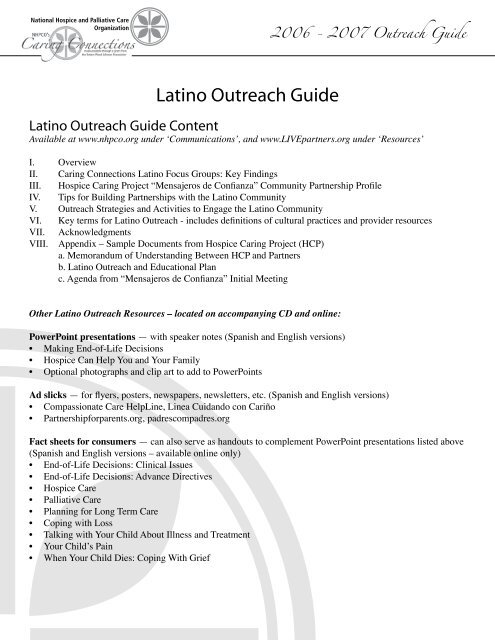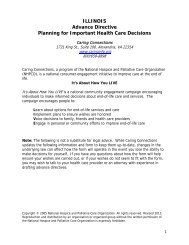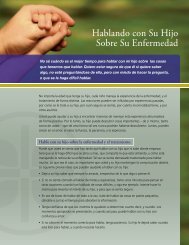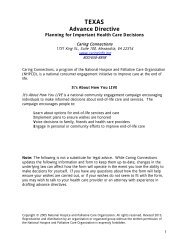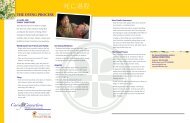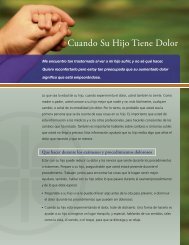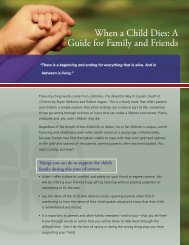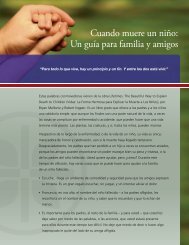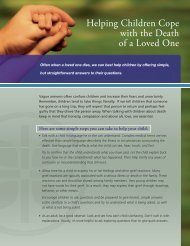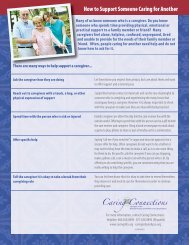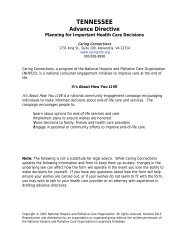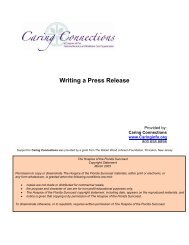Latino Outreach Guide Content - Caring Connections
Latino Outreach Guide Content - Caring Connections
Latino Outreach Guide Content - Caring Connections
Create successful ePaper yourself
Turn your PDF publications into a flip-book with our unique Google optimized e-Paper software.
National Hospice and Palliative Care<br />
Organization<br />
2006 - 2007 <strong>Outreach</strong> <strong>Guide</strong><br />
<strong>Latino</strong> <strong>Outreach</strong> <strong>Guide</strong><br />
<strong>Latino</strong> <strong>Outreach</strong> <strong>Guide</strong> <strong>Content</strong><br />
Available at www.nhpco.org under ‘Communications’, and www.LIVEpartners.org under ‘Resources’<br />
I. Overview<br />
II. <strong>Caring</strong> <strong>Connections</strong> <strong>Latino</strong> Focus Groups: Key Findings<br />
III. Hospice <strong>Caring</strong> Project “Mensajeros de Confianza” Community Partnership Profile<br />
IV. Tips for Building Partnerships with the <strong>Latino</strong> Community<br />
V. <strong>Outreach</strong> Strategies and Activities to Engage the <strong>Latino</strong> Community<br />
VI. Key terms for <strong>Latino</strong> <strong>Outreach</strong> - includes definitions of cultural practices and provider resources<br />
VII. Acknowledgments<br />
VIII. Appendix – Sample Documents from Hospice <strong>Caring</strong> Project (HCP)<br />
a. Memorandum of Understanding Between HCP and Partners<br />
b. <strong>Latino</strong> <strong>Outreach</strong> and Educational Plan<br />
c. Agenda from “Mensajeros de Confianza” Initial Meeting<br />
Other <strong>Latino</strong> <strong>Outreach</strong> Resources – located on accompanying CD and online:<br />
PowerPoint presentations — with speaker notes (Spanish and English versions)<br />
• Making End-of-Life Decisions<br />
• Hospice Can Help You and Your Family<br />
• Optional photographs and clip art to add to PowerPoints<br />
Ad slicks — for flyers, posters, newspapers, newsletters, etc. (Spanish and English versions)<br />
• Compassionate Care HelpLine, Linea Cuidando con Cariño<br />
• Partnershipforparents.org, padrescompadres.org<br />
Fact sheets for consumers — can also serve as handouts to complement PowerPoint presentations listed above<br />
(Spanish and English versions – available online only)<br />
• End-of-Life Decisions: Clinical Issues<br />
• End-of-Life Decisions: Advance Directives<br />
• Hospice Care<br />
• Palliative Care<br />
• Planning for Long Term Care<br />
• Coping with Loss<br />
• Talking with Your Child About Illness and Treatment<br />
• Your Child’s Pain<br />
• When Your Child Dies: Coping With Grief
National Hospice and Palliative Care<br />
Organization<br />
2006 - 2007 <strong>Outreach</strong> <strong>Guide</strong><br />
I. Overview<br />
As the number of <strong>Latino</strong>s living in the United States continues to increase, it is vitally important for hospices<br />
and end-of-life coalitions to expand outreach and programmatic efforts to ensure <strong>Latino</strong>s receive<br />
quality end-of-life care. NHPCO’s <strong>Caring</strong> <strong>Connections</strong> has created a <strong>Latino</strong> <strong>Outreach</strong> <strong>Guide</strong> to provide you<br />
with ideas and resources to guide your outreach efforts. We have included resources that are in English and<br />
Spanish to help you reach out to Spanish-speaking individuals and communities.<br />
In 2005, Hospice <strong>Caring</strong> Project of Scotts Valley, CA, formed a <strong>Latino</strong> community partnership called “Mensajeros<br />
de Confianza” (“Trusted Advisors”) to engage local health and human service professionals in a<br />
conversation about end-of-life care for the <strong>Latino</strong> population. The <strong>Latino</strong> <strong>Outreach</strong> <strong>Guide</strong> highlights this<br />
partnership as a model for hospices and coalitions who would like to expand their community outreach to the<br />
<strong>Latino</strong> population.<br />
Please refer to the ‘Key Terms for <strong>Latino</strong> <strong>Outreach</strong>’ document which includes phrases or words you may<br />
encounter when interacting with the <strong>Latino</strong> population. While the <strong>Latino</strong> community in this country is composed<br />
of many different cultures and nations, most <strong>Latino</strong>s in the United States have Mexican roots. Therefore,<br />
we have emphasized Mexican culture and heritage in these materials, while recognizing that there will<br />
be variations in many communities. As with all successful outreach efforts, the characteristics of the community<br />
or region should always be taken into account.<br />
As you begin to implement your outreach activities, please feel free to adapt the resources included in the<br />
<strong>Outreach</strong> <strong>Guide</strong> to serve your specific needs, however, we ask that you credit <strong>Caring</strong> <strong>Connections</strong>. You can<br />
contact us at caringinfo@nhpco.org and we will provide you with the text for your credits since our materials<br />
are copyrighted.
National Hospice and Palliative Care<br />
Organization<br />
2006 - 2007 <strong>Outreach</strong> <strong>Guide</strong><br />
II. <strong>Caring</strong> <strong>Connections</strong> <strong>Latino</strong> Focus Groups:<br />
Key Findings<br />
In May of 2006, Lake Research Partners (LRP) conducted four focus groups with <strong>Latino</strong>s for <strong>Caring</strong> <strong>Connections</strong>,<br />
a program of the National Hospice and Palliative Care Organization (NHPCO). These focus groups<br />
were part of a broader study aimed at informing NHPCO’s outreach and communication efforts to diverse racial<br />
and ethnic communities. Since the goal of community outreach is to engage people in end-of-life discussions<br />
before they are faced with a crisis, the focus groups were conducted with middle-aged <strong>Latino</strong>s who had not lost<br />
a loved-one in the recent past and had never had a life-threatening illness or injury. Two groups were conducted<br />
in Spanish, in Houston, and two were conducted in English in Los Angeles.<br />
The following are some preliminary recommendations from the focus groups conducted in May 2006.<br />
Advance Care Planning<br />
Although the majority of <strong>Latino</strong>s are unfamiliar with the concept of advance care planning, advance care planning<br />
resonated with the <strong>Latino</strong> community and participants felt basic education materials would be helpful.<br />
<strong>Latino</strong>s, more than other Americans, are more likely to have planned for what will happen after death. They<br />
may have made funeral plans, purchased life insurance, or written a will. Participants discussed the importance<br />
for family members to come to consensus about the care of loved ones.<br />
A majority of focus group participants said they personally would not want to be kept alive on life support, but<br />
are more divided about withholding life support from a loved one. Brief, descriptive resources on end-of-life<br />
topics including artificial nutrition and hydration are needed.<br />
End-of-Life Caregiving<br />
A better understanding of the term caregiver is needed within the <strong>Latino</strong> community. For many <strong>Latino</strong>s the term<br />
“caregiver” implies a professional role such as that of a nurse or home health aid. Family caregivers may not<br />
identify themselves as such since caring for family members at home is part of their culture and tradition.<br />
Hospice<br />
It is important to emphasize to <strong>Latino</strong>s the importance of family in hospice care. Some <strong>Latino</strong>s have not heard<br />
of hospice, and many who have do not know much about it. Some equate hospice with nursing homes. Nursing<br />
homes have negative connotations in <strong>Latino</strong> families because they go against the cultural tradition of the family<br />
providing care for the sick and elderly. It was with this focus group that the term “compassionate care” was<br />
found to be more effective than “hospice.”
National Hospice and Palliative Care<br />
Organization<br />
2006 - 2007 <strong>Outreach</strong> <strong>Guide</strong><br />
III. Hospice <strong>Caring</strong> Project’s<br />
“Mensajeros de Confianza” Community Partnership Profile<br />
Hospice <strong>Caring</strong> Project (HCP), a hospice provider that serves the Santa Cruz area in California, raised<br />
$170,000 from three funders for an eighteen month “Challenge of Change” initiative to:<br />
• Learn about preferences involving terminal illness, death, and bereavement for the local <strong>Latino</strong> community,<br />
and<br />
• Develop a plan for lessening barriers to hospice that will enable HCP to successfully deliver end-of-life care<br />
to this community.<br />
It took a significant amount of time for HCP to gather information from the local community, create and expand<br />
community partnerships, and build awareness about end-of-life issues in the local <strong>Latino</strong> community. From<br />
their experience, HCP found that:<br />
•<br />
•<br />
•<br />
It is imperative that culturally-relevant practices and procedures are integrated into all services.<br />
A strong internal committee and a strong external advisory committee must support the project.<br />
To best identify service barriers and develop the means to remedy them, the target community must be involved<br />
in your organization as a partner.<br />
There were several structural changes that HCP made in order to achieve their objectives. Specifically, HCP:<br />
• Hired bilingual/bicultural clinicians and staff when possible.<br />
• Created a new bilingual/bicultural <strong>Latino</strong> Community Liaison position to coordinate outreach<br />
A high school educated Latina woman was hired who brought her ties to the community (fifteen years working<br />
at a local clinic) and the right personal traits (an outgoing personality, compassion, and strong communication<br />
skills) to the position.<br />
• Actively recruited <strong>Latino</strong> leaders to serve on HCP board.<br />
• Provided cultural competency training sessions for all HCP staff.<br />
• Incorporated goals and objectives for serving the <strong>Latino</strong> community into their strategic plan ensuring a level<br />
of accountability to the Board of Directors and the management team.<br />
• Integrated knowledge from research conducted with the <strong>Latino</strong> community and gained from community<br />
partners into day-to-day operations to ensure that all HCP staff work together to provide compassionate endof-life<br />
care to <strong>Latino</strong>s.<br />
Community Partnerships<br />
HCP recruited three key partners (a non-profit community health clinic, an umbrella group for Catholic charities,<br />
and an organization that supports women with a cancer diagnosis) as their primary collaborators. HCP<br />
established a ‘Memorandum of Understanding’ with these agencies, agreeing to share knowledge, resources,<br />
and provide HCP with referrals to <strong>Latino</strong> families in need of hospice and bereavement services (see appendix).<br />
Mensajeros de Confianza (“Trusted Advisors”) Advisory Committee<br />
The three original partnership organizations served as founding members of the Mensajeros de Confianza, an<br />
external advisory committee, that grew to include 28 organizations of diverse size and purpose who serve the<br />
local <strong>Latino</strong> community; a majority of members are <strong>Latino</strong>. Establishing the three initial partnerships gave<br />
continued on next page
National Hospice and Palliative Care<br />
Organization<br />
2006 - 2007 <strong>Outreach</strong> <strong>Guide</strong><br />
credibility and importance to the development of Mensajeros de Confianza, and their commitment encouraged<br />
others to attend, as did familiarity with HCP’s <strong>Latino</strong> Community Liaison from her previous affiliation with the<br />
local health clinic.<br />
Through its monthly meetings, Mensajeros de Confianza, has become an important resource for HCP to engage<br />
the larger community of local health and human service professionals in a conversation about end-of-life education<br />
for the <strong>Latino</strong> population. Importantly, Mensajeros de Confianza evolved into a community forum for<br />
addressing a wide range of <strong>Latino</strong> service barriers affecting various health and social service disciplines. A diverse<br />
group of organizations, from the media, business, and political communities, as well as traditional service<br />
providers, are fully engaged in supporting each other, educating each other in their respective community roles,<br />
and discussing how they can work together to ensure that all community members are equally served.<br />
Family Interviews<br />
To begin their focus on <strong>Latino</strong> families, the <strong>Latino</strong> Community Liaison at HCP and an experienced bilingual<br />
counselor conducted 8 interviews with <strong>Latino</strong>s whose family members had previously used HCP’s services.<br />
Through the interviews, HCP gained information about end-of-life beliefs, concerns, and traditions.<br />
Interviewees made it clear that bilingual and bicultural staff made a significant contribution to their hospice experience.<br />
They described cultural nuances such as the importance of family unity, and family member visiting<br />
from their home country at the end of life, in which case travel and immigration assistance is very important.<br />
All interviewees discussed the importance of the El Novenario ritual, common in many Latin American countries,<br />
where the body of the deceased is held in the home for a minimum of 24 hours.<br />
Lastly, interviewees felt that an important way to reach the <strong>Latino</strong> community is through Spanish language television,<br />
radio, and diverse print media.<br />
Internal Workgroup<br />
In order to ensure that HCP incorporated outreach to <strong>Latino</strong>s throughout its structure, an internal workgroup<br />
was formed, composed of the Executive Director, Director of Clinical Services, Director of Volunteer Services,<br />
<strong>Latino</strong> Community Liaison, bilingual/bicultural nurses, home health aides, and a bilingual social worker who<br />
met monthly to discuss systems issues related to serving <strong>Latino</strong>s.<br />
The presence of bilingual/bicultural employees was very important because they are the first to know if an approach<br />
that HCP uses is being received well or should be reconsidered. The Internal Workgroup also addressed<br />
many of the issues that arose at the Mensajeros de Confianza Advisory Committee meetings and contributed to<br />
the development of community outreach materials. In addition, the internal workgroup discussed how to best<br />
serve <strong>Latino</strong> families using HCP services.<br />
Culturally-Relevant Bilingual Materials<br />
Another important component of the outreach HCP has done has been retaining a part-time Spanish language<br />
consultant for the purpose of translating HCP admittance forms and other appropriate documentation, translating<br />
recruitment information targeting bilingual/bicultural personnel and developing a Spanish-language HCP<br />
continued on next page
National Hospice and Palliative Care<br />
Organization<br />
2006 - 2007 <strong>Outreach</strong> <strong>Guide</strong><br />
brochure and accompanying outreach materials. This consultant worked closely with the <strong>Latino</strong> Community<br />
Liaison and the other members of the internal committee geared towards <strong>Latino</strong> initiatives.<br />
Community research and family interviews revealed that materials describing HCP services could not just be<br />
translated; they needed to be “transcreated” (translated to ensure that they make sense both literally and culturally)<br />
to address the concerns and end-of-life traditions of the <strong>Latino</strong> community. Members of the Mensajeros<br />
de Confianza advisory committee contributed to a review and adaptation of the materials, drawing upon their<br />
own agencies’ experiences and their bicultural backgrounds. HCP created two brochures, one in English and<br />
one in Spanish, to introduce hospice care and the ways in which HCP can help at the end of life. Additionally,<br />
the internal translation group is creating a “photonovella” for low-literacy <strong>Latino</strong>s, describing hospice services<br />
through photographs and simple text.<br />
Building Awareness<br />
Awareness about end-of-life choices is building in the <strong>Latino</strong> community that HCP serves. The ongoing support<br />
of the Mensajeros de Confianza advisory committee and the presence of bilingual, bicultural staff members at<br />
community events have gradually raised the profile of HCP and end-of-life care in the community. The experience<br />
of HCP emphasizes that change is gradual and building trust with a <strong>Latino</strong> community takes time. The<br />
ongoing, consistent efforts of HCP have made community partnerships flourish and a vital discussion regarding<br />
service barriers facing the <strong>Latino</strong> population has ensued.<br />
At the conclusion of the eighteen month project HCP is witnessing a new direction in their <strong>Latino</strong> community—<br />
there is greater awareness, collaboration and interest in end-of-life education. HCP is being invited to conduct<br />
in-service presentations, participate in community events and present their expertise in community forums previously<br />
unreceptive or unknown to them.<br />
For example, in April 2006, HCP hosted a representative from the Mexican Consulate at the Mensajeros de<br />
Confianza meeting. The rich discussion focused on end-of-life issues including the transportation of bodies<br />
back to Mexico and the challenges of bringing family members from Mexico to be with their loved ones at the<br />
time of death. Members of the Mensajeros de Confianza have expressed interest in inviting the INS (Immigration<br />
and Naturalization Service) to attend a future meeting to help build awareness and relationships that can<br />
benefit our community.<br />
<strong>Latino</strong> <strong>Outreach</strong> Plan<br />
Using the findings from the family surveys and the Mensajeros de Confianza, HCP developed and implemented<br />
a written ‘<strong>Latino</strong> <strong>Outreach</strong> and Educational Plan’ designed to meet specific goals, objectives, and outcomes.<br />
(see appendix).<br />
Over 250 <strong>Latino</strong>s have received information directly about HCP services through speaking engagements and interactions<br />
with HCP staff and volunteers at community events and an advance directive workshop. Community<br />
events where HCP has had a presence include a Mexican Independence Day celebration, a local woman of the<br />
year award, and <strong>Latino</strong> business association meetings.<br />
continued on next page
National Hospice and Palliative Care<br />
Organization<br />
2006 - 2007 <strong>Outreach</strong> <strong>Guide</strong><br />
Lessons Learned<br />
HCP feels that even with the significant internal changes they adopted to serve the <strong>Latino</strong> community and the<br />
comprehensive approach they have taken towards community outreach with <strong>Latino</strong>s, the targeted community<br />
must be ready to learn about end-of-life issues to truly improve access to care. It is important to build trust as<br />
well as awareness in a community and this process often happens one family at a time. HCP has acknowledged<br />
past weaknesses in serving the <strong>Latino</strong> community and made a commitment to learning.<br />
Through this initiative, HCP has brought awareness to the fact that many <strong>Latino</strong>s do experience the benefits of<br />
hospice care. By fostering a continual and compelling conversation about the end of life with the Mensajeros<br />
de Confianza, HCP has broadened and effectively increased their visibility with community agencies, leaders,<br />
health and human service professionals and organizations serving the <strong>Latino</strong> community. Through these meetings,<br />
HCP has begun to develop a safety net of community resources that will encourage <strong>Latino</strong> families to seek<br />
hospice, and also help our larger community of service providers enhance their methods of service within the<br />
community.<br />
For more information contact:<br />
Salima Cobb<br />
Professional Liaison<br />
Hospice <strong>Caring</strong> Project<br />
(831) 430-3004<br />
scobb@hospicesantacruz.org
National Hospice and Palliative Care<br />
Organization<br />
2006 - 2007 <strong>Outreach</strong> <strong>Guide</strong><br />
IV. Tips for Building Partnerships with the <strong>Latino</strong> Community<br />
Build trust<br />
One of the most important things that any organization must do when working with a cultural community for<br />
the first time is to build trust. Gaining the trust of a community takes time. Building trust needs to be your<br />
main goal in building partnerships. Below are suggestions that can help your organization or coalition to build<br />
trust with the <strong>Latino</strong> Community.<br />
Recruit a liaison to the community<br />
One of the cornerstones of your outreach needs to include the involvement of a bilingual, bicultural person already<br />
well connected to the local <strong>Latino</strong> community. Think broadly about who might be the best person for your<br />
outreach—focus on the person and his or her qualities and skills, such as his or her ease of working with people,<br />
rather than only on traditional qualifications, such as education level. It is important to assess his/her credibility<br />
with and access to the people you are trying to reach. Be sure the person you select is respected in the community.<br />
Get feedback<br />
Seek input from your local <strong>Latino</strong> community and interview families who have received hospice services and<br />
learn about their experiences. In order to successfully provide services to <strong>Latino</strong>s, it is essential for the members<br />
of your <strong>Latino</strong> community to describe their experiences with hospice and voice their desires and concerns<br />
about end-of-life care.<br />
Below is a sample of questions that Hospice <strong>Caring</strong> Project used for their family interviews:<br />
• How did you learn about Hospice <strong>Caring</strong> Project From someone at the hospital, a friend or<br />
family member<br />
• What did you think when you first heard about hospice<br />
• How did the people from hospice help<br />
• What did you and your family most need when your loved one was in the last stage of her/his life<br />
Personally, practically, spiritually And afterward<br />
• What are the main traditions in México when someone dies<br />
• Which of these traditions do you consider that hospice should be aware of to better serve your<br />
family<br />
• What are some ways to take the message of hospice into Mexicano/<strong>Latino</strong> communities<br />
• Would you be willing to speak of your experience with hospice to help us tell others about our<br />
services<br />
Establish clear goals<br />
After you have gathered information from your community, develop clear goals for your outreach. Once you<br />
have collected feedback from the <strong>Latino</strong> community, goals should be formulated and clearly stated to serve as<br />
a guide for your outreach process. Incorporate your goals for engaging the <strong>Latino</strong> community to the strategic<br />
plan of your organization or coalition. This guarantees a long term commitment to cultivating relationships with<br />
and serving the <strong>Latino</strong> community. Having the goals in the strategic plan can help to ensure adequate time and<br />
attention is given for program development and funding (see appendix).<br />
continued on next page
National Hospice and Palliative Care<br />
Organization<br />
2006 - 2007 <strong>Outreach</strong> <strong>Guide</strong><br />
Create an advisory committee<br />
Create formal relationships with a few key service providers to build bridges to the people who need your services.<br />
In order to do <strong>Latino</strong> outreach, form an Advisory Committee composed of community stakeholders who<br />
will assist you in the development of culturally competent services. To initiate this process, focus first on a few<br />
key service providers who will be most important to your work.<br />
Since most service providers, especially the ones that would be most influential and therefore the best partners,<br />
are very busy and their time is valuable, consider drawing up a formal ‘Memorandum of Understanding’ (see<br />
appendix) and setting aside a certain amount of money for each organization for their services if possible. A<br />
formal relationship can be the key factor to ensure your Advisory Committee has a strong start, as these organizations<br />
will be your initial Advisory Committee members.<br />
• Recruit community stakeholders: Invite organizations and influential individuals to also join the Advisory<br />
Committee after you have initial members in place. Do your homework to learn who is influential in the<br />
community and then meet with potential members to explain what you are trying to accomplish. Individuals<br />
who may be influential in the <strong>Latino</strong> community include clergy, those who work with migrant farm workers,<br />
union organizers, and local <strong>Latino</strong> businesses. Other stakeholders include health and human service organizations,<br />
the political community (local town and county representatives) and possibly a local foreign consulate<br />
(example: Consul of Mexico).<br />
• Make meetings meaningful: The function of the Advisory Committee includes encouraging and accepting<br />
their advice for your outreach, reciprocal learning among committee members and enabling the members<br />
to collaborate to better serve the community as whole. Advisory Committee meetings need to be a time to<br />
gather input from committee members and to welcome advice that they have for various aspects of your<br />
outreach activities which can include questions about terminology to the best venues in which for outreach<br />
activities. It is important to report back to the committee about ways in which their advice and input has<br />
been used to shape different aspects of the community outreach your hospice is doing.<br />
Meetings are also an excellent time for committee members to learn from each other, and to have time to<br />
discuss their own organization. It may be the case that bringing people together around end-of-life issues<br />
serves a larger community purpose, if there has not already been a way for service providers for the <strong>Latino</strong><br />
community to collaborate and create a better network. The more that the attendees are gaining from the<br />
meeting, the stronger their commitment to the Advisory Committee will be. Therefore, looking at the wider<br />
community picture should benefit the Committee and your organization or coalition (see appendix).<br />
The following are suggestions from Hospice <strong>Caring</strong> Project on how to conduct a successful advisory<br />
committee meeting:<br />
•<br />
•<br />
Provide food.<br />
Provide a convenient meeting time and place. Ask the group to decide on frequency of<br />
meetings.<br />
•<br />
•<br />
Meetings need to be participatory as well as educational.<br />
Have 1 or 2 service providers give a brief presentation about their organization during each<br />
meeting. If participants are comfortable doing this, ask them to give a quick update of what<br />
is currently a focus in their organization at the beginning of every meeting.<br />
• Leave time for networking amongst attendees.<br />
continued on next page
National Hospice and Palliative Care<br />
Organization<br />
2006 - 2007 <strong>Outreach</strong> <strong>Guide</strong><br />
• Always have at least one subject that you want advice on. Follow-up on past issues where advice<br />
has been given and then let them know what you have done that incorporates their input.<br />
• Convey as often as possible to the Committee that their expertise and participation is a<br />
greatly valuable asset to your organization or coalition.<br />
• Send out minutes to those who attended and those who could not attend.<br />
• Stay connected: Email can be a very effective means of communicating and staying connected with<br />
Advisory Committee members between meetings. Asking advice on the use of a Spanish term, or letting<br />
members know that your organization had a successful experience at an outreach event can demonstrate<br />
the commitment that you have to using the Advisory Committee and learning from its members. Careful<br />
use of an email listserv can help to reinforce your organization’s commitment and serve as another way of<br />
building trust.<br />
Focus on relationships, not projects<br />
In our goal-oriented society, it is all too easy to focus on project goals. One of the gifts that the <strong>Latino</strong> culture<br />
provides to us is the reminder to focus on relationships. Meaningful relationships always provide the best<br />
results. So when you are getting too stressed about your all work-related projects, sit back and enjoy your new<br />
friends from a different culture. This is the best guarantee to successfully build partnerships and implement<br />
outreach activities with the <strong>Latino</strong> community.<br />
Special thanks to the Hospice <strong>Caring</strong> Project, Scotts Valley, CA, for their insights and contributions to this<br />
document.
National Hospice and Palliative Care<br />
Organization<br />
2006 - 2007 <strong>Outreach</strong> <strong>Guide</strong><br />
V. <strong>Outreach</strong> Strategies and Activities to Engage the <strong>Latino</strong> Community<br />
The following are examples of outreach strategies and activities that were used by Hospice <strong>Caring</strong> Project<br />
(HCP) and others to engage with the <strong>Latino</strong> community around end-of-life issues.<br />
Photonovella (Fotonovela)<br />
Create a fotonovela to promote hospice, advance care planning or other topics. A fotonovela is a small booklet<br />
in picture story form with narration which can be used to carry a message or educational information. A<br />
fotonovela uses photos rather than drawings to illustrate a story. In Mexico, the fotonovela is a popular way<br />
to convey information about things like social norms and health messages, and is an easy way to communicate<br />
with people who have limited literacy skills.<br />
Hospice <strong>Caring</strong> Project created a fotonovela that demonstrates hospice services in action and provides<br />
information about how to refer someone to hospice care. The story begins outside the church<br />
after mass, where two women friends are talking. One woman asks her friend, the wife of a very<br />
sick man, “How are you doing” The woman tells her story and her husband’s, and then her friend<br />
reacts by explaining what hospice is. The wife of the sick man later calls a hospice. The fotonovela<br />
illustrates the process of becoming a hospice patient, receiving services, the experience of the family<br />
and the support hospice offers following the death of the family member. Most of this is conveyed in<br />
pictures and there are also a few sidebars with information.<br />
English as Second Language (ESL) Classes<br />
Make connections with local ESL programs. They often have guest speakers who come to explain a particular<br />
community organization. Many students in ESL programs have recently arrived from another country, are a<br />
range of ages and have a variety of experiences. Many stories are told during a class and therefore it is a great<br />
time to spark a discussion about community resources regarding family caregiving, hospice, advance care planning<br />
and grief support.<br />
The presentations are done in English but since students are not yet fluent in English some things are explained<br />
in Spanish to ensure that the class completely understands the information. ESL instructors want to encourage<br />
students to practice their English skills and further their comprehension, but also want to make sure the presentations<br />
are worthwhile for all.<br />
Students are learning English in order to get jobs, and many have a special interest in healthcare jobs. They will<br />
go on to work in radiology, dentistry, hospitals, and skilled nursing facilities. These new healthcare workers<br />
often become resources for their families when they need knowledge on health related issues. By speaking to<br />
people soon after their arrival in America, you can plant seeds about hospice—educating them about a service<br />
available in their new country, and potentially interesting them in working in end-of-life care.<br />
Migrant Workers<br />
Many <strong>Latino</strong>s in the United States are migrant workers, especially in rural areas. Often migrant workers speak only<br />
Spanish and have sub-standard access to health care and education. Usually, you will be able to find local social<br />
service programs that have been developed to assist them. By partnering with these established programs you will be<br />
continued on next page
National Hospice and Palliative Care<br />
Organization<br />
2006 - 2007 <strong>Outreach</strong> <strong>Guide</strong><br />
associated with a trusted entity and therefore have an easier time educating the workers about end-of-life care.<br />
Many migrant workers are young and have school-aged children. Some school systems have designated teachers<br />
or administrators who work with migrant parents who are new to a school system and may require special<br />
attention as they enroll their children. In the experience of Hospice <strong>Caring</strong> Project, meetings of migrant parents<br />
organized by the school are especially well attended, and are a good place to reach people with informal presentations<br />
and literature.<br />
Spanish-language Newspapers and Radio<br />
Many <strong>Latino</strong>s receive information about local services through Spanish-language newspapers. Many Spanish-language<br />
newspapers are not daily papers—they may only be weekly, biweekly or monthly. Contact <strong>Latino</strong><br />
service providers in your area to discover which publications might provide a free or reduced-rate advertisement<br />
on end-of-life issues. Because of the extensive healthcare needs of the <strong>Latino</strong> community, some newspaper<br />
publishers may have a policy of allowing health organizations or non-profit groups to advertise for free.<br />
Radio is another good way to reach the Spanish-speaking population. Even if your area does not have a regular<br />
radio station for Spanish-speakers, you may find that there are one or more low wattage radio stations in your<br />
area that are important to the <strong>Latino</strong> community. A public service announcement could be an excellent way of<br />
reaching this audience, and again, it is likely that the stations welcome PSAs from health organizations since<br />
many <strong>Latino</strong>s do not have access to good healthcare.<br />
Hispanic PR Wire<br />
Hispanic PR Wire, Inc. (HPRW) is a Miami-based news distribution service reaching U.S. Hispanic media,<br />
organizations and opinion leaders nationwide. HPRW features a complete menu of Hispanic media circuits that<br />
includes the options of national, state and U.S.-based Pan Regional Latin America distributions. In addition,<br />
Hispanic PR Wire offers specialized distribution targeting <strong>Latino</strong> organizations as well as Hispanic elected officials<br />
and opinion leaders.<br />
On their Web site, www.hispanicprwire.com, go to “Top <strong>Latino</strong> Links” to link to popular media outlets all over the<br />
United States. HPRW offers a free monthly newsletter via email, the Hispanic PR Monitor. Sign up is available<br />
on their Web site or, send an email with your full contact information to hispanicprmonitor@yahoo.com.<br />
Local Farmer’s Market<br />
Farmer’s markets tend to be popular with many <strong>Latino</strong>s, especially recent immigrants, because fresh vegetables<br />
are very important to them and families always cook and eat at home.<br />
Hospice <strong>Caring</strong> Project found that the local farmer’s market has a booth paid for by the County Health<br />
and Human Services that signs up local organizations to provide information. At their booth, Hospice<br />
<strong>Caring</strong> Project displays a photo board they created that illustrates the hospice circle of care with photos<br />
of a local family as well as the <strong>Latino</strong> staff of HCP. Often the HCP booth has as many as 40 direct<br />
contacts each time they attend the farmer’s market, giving staff the opportunity to answer people’s<br />
questions and distribute written materials.<br />
continued on next page
National Hospice and Palliative Care<br />
Organization<br />
2006 - 2007 <strong>Outreach</strong> <strong>Guide</strong><br />
Pharmacies<br />
Pharmacies and drugstores are a good source of health information for many people and many <strong>Latino</strong>s rely upon<br />
their services. Speak with your local pharmacy to see if they would be willing to have Spanish-language materials<br />
available on end-of-life issues to distribute.<br />
Health Clinics<br />
Local health clinics can be another excellent way of reaching the <strong>Latino</strong> population. Find out which clinics in<br />
your area serve the <strong>Latino</strong> community and ask to distribute Spanish-language information or make a display for<br />
their patients.<br />
Funeral Directors<br />
In the <strong>Latino</strong> focus groups conducted for <strong>Caring</strong> <strong>Connections</strong>, it was revealed that many younger <strong>Latino</strong>s make<br />
funeral arrangements in advance. Talk to local funeral directors in your area about their experience with the <strong>Latino</strong><br />
community and see if they have done outreach to the <strong>Latino</strong> community. You may be able to partner with<br />
them to provide other end-of-life information.<br />
If you have successful outreach strategies and activities that you have implemented in your community and<br />
would like to include in the online version of this document, please contact:<br />
Ashley Hammarth, MPH<br />
Manager, Partner Programs and Services, <strong>Caring</strong> <strong>Connections</strong>/NHPCO<br />
ahammarth@nhpco.org, 703-647-6689
National Hospice and Palliative Care<br />
Organization<br />
2006 - 2007 <strong>Outreach</strong> <strong>Guide</strong><br />
VI. Key Terms for <strong>Latino</strong> <strong>Outreach</strong><br />
Key terms that may help you with your outreach to the <strong>Latino</strong> community are defined below.<br />
Bicultural<br />
A person who is bicultural is part of two distinct cultures, such as Mexican and American cultures. A bilingual/<br />
bicultural <strong>Latino</strong> staff person will be able to relate more effectively to <strong>Latino</strong> families while doing outreach than<br />
someone who is just bilingual. Bicultural staff are much more adept at building trust with <strong>Latino</strong> communities<br />
than people who are solely bilingual.<br />
Bilingual<br />
A person who is bilingual is able to comfortably speak two languages, with equal or near equal fluency.<br />
Curanderismo<br />
Curaderismo is a form of folk healing which includes various techniques such as prayer, herbal medicine, healing<br />
rituals, spiritualism, massage, and psychic healing. It is a system of beliefs that is common throughout Latin<br />
America. Like other forms of alternative medicine, there are reports that these practices can improve symptoms,<br />
alleviate pain, and relieve stress. Hospice patients may desire to have curanderismo included in their care.<br />
Some curaderismo practices are well known by lay people and are done at home, but sometimes the advice or<br />
practice of a specially trained healer, a curandero/curandera, is sought.<br />
Day of the Dead (Día de los Muertos)<br />
The Day of the Dead is an important Mexican holiday and social ritual that recognizes the cycle of life and<br />
death. This is a festival that has roots in Aztec culture yet it has Christian overtones. Each year on November<br />
1st and 2nd, families welcome the dead back into their homes and visit the graves of their loved ones. In general,<br />
people from urban areas in Mexico are not as likely to celebrate this holiday, but it retains great importance<br />
in rural communities. The traditions surrounding the Day of the Dead may serve as an avenue for discussing<br />
end-of-life issues.<br />
Familismo (Family)<br />
<strong>Latino</strong>s place a great deal of importance on the family as the primary source of support and information. Help<br />
and advice are usually sought from the family, and important decisions are made as a group. Medical conditions<br />
and treatment are considered a family matter.<br />
Fatalismo (Fatalism)<br />
Traditionally, many <strong>Latino</strong>s view an illness as either “natural” (caused by God’s will or fate) or “unnatural”<br />
(caused by evil done to one by another.) In either case, a person feels that control over the illness has an external<br />
influence, and is out of his or her hands. This concept of illness has led to a fatalistic view of life and<br />
death—resulting in a person feeling that they have little to do with the success or failure of an illness. It is<br />
suspected that belief in fatalism may be in part a reason that <strong>Latino</strong>s have higher rates of advanced disease at<br />
the time of diagnosis.<br />
continued on next page
National Hospice and Palliative Care<br />
Organization<br />
2006 - 2007 <strong>Outreach</strong> <strong>Guide</strong><br />
Hispanic<br />
While “Hispanic” is a widely accepted term and often used interchangeably with “<strong>Latino</strong>”, “Hispanic” accurately<br />
refers only to people from Spanish-speaking countries. “Hispanic” is the term currently used by the US government<br />
to define citizens of any race whose family is originally from a Spanish-speaking nation. In contrast,<br />
in Latin America, the term “Hispano” (Hispanic) often refers only to people who trace their ancestry to Spain,<br />
and does not include those of indigenous or African heritage. Because of these complexities, “<strong>Latino</strong>” (defined<br />
below) generally seems to be the more flexible and accurate term. Listen to the people in your own community<br />
and refer to their group with a term that people feel is accurate and respectful.<br />
Hospicio<br />
While “hospicio” has been adopted by the hospice movement in many Spanish-speaking countries as well as<br />
by US hospices doing outreach in <strong>Latino</strong> communities, it is important to note that the term “hospicio” can have<br />
negative connotations for <strong>Latino</strong>s. People unfamiliar with the concept of hospice care may assume that “hospicio”<br />
is a bad place that is of no interest to them.<br />
Throughout Latin America, the term “hospicio” has historically been associated with institutions for the mentally<br />
ill, the mentally retarded, and the poor or homeless. A well known mental hospital in Ecuador, “Hospital<br />
Psiquiátrico San Lázaro” is known locally as “el Hospicio”. In Mexico, the term “hospicio para ninos” was<br />
traditionally the term for an orphanage while “hospicio de pobres” (literally, hospice of poor men) was the term<br />
for the poor house.<br />
Some hospices in the United States have chosen to use the English word “hospice” in Spanish language documents<br />
to distinguish it from the negative history of “hospicio.”<br />
<strong>Latino</strong><br />
This term is used to describe anyone from a Latin American country, whether the person speaks Spanish, Portuguese,<br />
or an indigenous language. The term <strong>Latino</strong> is more accurate than the term “Hispanic” which refers only<br />
to people who speak Spanish. While both of these terms are widely accepted, many <strong>Latino</strong>s are uncomfortable<br />
being treated as one large group, since Latin America is a continent with many nations and varied cultural traditions.<br />
Therefore, while it is useful to use this term to refer to a large subset of people in the United States, it is<br />
important to listen to the people in your own community and refer to their group with a term that people feel is<br />
accurate and respectful.<br />
El Novenario/ La Novena<br />
This term is a spiritual mourning ritual that traditionally lasts nine days. Traditionally, in Latin American countries<br />
the body of the deceased was held in the home for nine days and family members prayed around it. Today,<br />
it is still common for the body to be held at home for at least twenty-four hours so that the family can pray and<br />
mourn, and this practice is still important to <strong>Latino</strong>s in the United States, especially in immigrant communities.<br />
After the body is removed, the bereaved family attends mass and prays for nine days following the death of the<br />
loved one. When serving <strong>Latino</strong> hospice patients, it is important to understand what the families’ expectations<br />
and needs will be directly following the death of the patient. (R. Falcon and C. Yoder Falcon: Salsa: A Taste of<br />
Hispanic Culture, Westport, CT: Prager, 1998.)<br />
continued on next page
National Hospice and Palliative Care<br />
Organization<br />
2006 - 2007 <strong>Outreach</strong> <strong>Guide</strong><br />
Transcreate<br />
The concept of “transcreation” is that documents should not just be translated word for word, but must be translated<br />
to ensure that they make sense both literally and culturally. Misunderstandings can often occur if materials<br />
are not translated in a culturally appropriate way. <strong>Latino</strong> culture is not monolithic—Mexican, Cuban, and<br />
Guatemalan people all have different dialects and expressions, and therefore, it is important to be familiar with<br />
your local <strong>Latino</strong> community when translating materials.<br />
Translate<br />
Translation of documents often means translating something word for word. Without someone who is bicultural<br />
doing the translation, it is common for literal translations to be confusing or wrong for the target audience.<br />
El Velorio<br />
This refers to the all night vigil following the death of a loved one. It is common for families to eat and drink<br />
with each other during this ritual, but the tone is still somber, one of mourning. In Latin American urban areas,<br />
el velorio may be conducted at a funeral home, but in the United States, it usually has to be done at home.<br />
(R. Falcon and C. Yoder Falcon: Salsa: A Taste of Hispanic Culture, Westport, CT: Prager, 1998.)
National Hospice and Palliative Care<br />
Organization<br />
2006 - 2007 <strong>Outreach</strong> <strong>Guide</strong><br />
VII. Acknowledgements<br />
<strong>Caring</strong> <strong>Connections</strong> would like to thank Hospice <strong>Caring</strong> Project of Santa Cruz County, CA, for their inspiration<br />
and guidance in creating the <strong>Latino</strong> <strong>Outreach</strong> <strong>Guide</strong>. The input of Ann Pomper, Executive Director,<br />
and Salima Cobb, Professional Liaison, has been essential to this process. Their “Mensajeros de Confianza”<br />
program is a model that we can all learn from to better serve <strong>Latino</strong> communities across the country.<br />
The National Alliance for Hispanic Health provided an incredible partnership opportunity to create the Compassionate<br />
Care HelpLine, Linea Cuidando con Cariño - a national service offering information in Spanish on<br />
end-of-life issues. We also would like to thank the Public Welfare Foundation for their generous support of the<br />
HelpLine. We hope that all of you will join us in the promotion and publicity of this valuable resource for <strong>Latino</strong>s<br />
in your community. (See the Ad slick included in the <strong>Outreach</strong> <strong>Guide</strong>.)<br />
The Children’s Hospice and Palliative Care Coalition spearheaded and developed partnershipforparents.org,<br />
the first-ever online support network for parents caring for children diagnosed with a serious illness available in<br />
both English and Spanish. The creation of these Web sites is a dream-come-true for all of us who want to see<br />
pediatric end-of-life issues acknowledged and supported. (See the Ad slick included in the <strong>Outreach</strong> <strong>Guide</strong>.)<br />
Most of all, The Robert Wood Johnson Foundation of Princeton, NJ, made this <strong>Outreach</strong> <strong>Guide</strong> and all <strong>Caring</strong><br />
<strong>Connections</strong> resources possible. We are very grateful for their continuing support.<br />
For assistance with the <strong>Latino</strong> <strong>Outreach</strong> <strong>Guide</strong>, email caringinfo@nhpco.org or call 1-800-658-8898.
National Hospice and Palliative Care<br />
Organization<br />
2006 - 2007 <strong>Outreach</strong> <strong>Guide</strong><br />
VIII: Appendix a:<br />
Challenge of Change Initiative<br />
Memorandum of Understanding<br />
Between Hospice <strong>Caring</strong> Project and ___[Partner]___<br />
Hospice <strong>Caring</strong> Project is developing relationships with Mensajeros de Confianza (trusted messengers within<br />
the <strong>Latino</strong> community) to help reach our goal of creating culturally-relevant end-of-life information and<br />
services to the <strong>Latino</strong> community. ___[Partner]___ agrees to enter into a collaborative agreement with Hospice<br />
<strong>Caring</strong> Project (HCP) by providing the following services for the Challenge of Change Initiative.<br />
• Follow-up counseling as needed for focus group participants: HCP is conducting focus group meetings with<br />
up to twelve families who have received HPC services. Family members may experience feelings of grief<br />
as a result of these meetings and will be encouraged to call the HCP program coordinator if needed. If the<br />
coordinator assesses that counseling is needed, she will make a referral to ___[Partner]___. ___[Partner]__<br />
will provide up to three counseling sessions at no charge to the client.<br />
• Review of translated materials: ___[Partner]___ will review translated materials (postcards, brochures, letters),<br />
consulting on cultural relevance of materials presented to the community.<br />
• HCP and ___[Partner]___ will partner to present in-service training on end-of-life care once during the<br />
year.<br />
• A system will be developed and documented for referring appropriate ___[Partner]___ families to HCP<br />
when appropriate.<br />
Funding:<br />
Hospice <strong>Caring</strong> Project will allocate $______ for services provided during the initial year of the grant cycle, and<br />
an additional $_____ during the second year.<br />
Ann Carney Pomper, Executive Director<br />
Hospice <strong>Caring</strong> Project Santa Cruz<br />
[Representative/Partner]<br />
Date<br />
Date
National Hospice and Palliative Care<br />
Organization<br />
2006 - 2007 <strong>Outreach</strong> <strong>Guide</strong><br />
VIII: Appendix b:<br />
Hospice <strong>Caring</strong> Project<br />
<strong>Latino</strong> <strong>Outreach</strong> and Educational Plan<br />
The following plan highlights Hospice <strong>Caring</strong> Project’s planned outreach services to the <strong>Latino</strong> community.<br />
A three-year agency strategic plan, adopted in August 2005 guides the daily operations of HCP services to<br />
the <strong>Latino</strong> community. The following measurable objectives and outcomes of the plan are reviewed and reported<br />
to the board on a monthly basis. Additionally, methods for increasing <strong>Latino</strong> share of census and outreach<br />
are reviewed quarterly at a quality assessment and improvement (QAandI) meeting of management and key<br />
staff.<br />
•<br />
•<br />
•<br />
Increase <strong>Latino</strong> share of census by 10% per year to 30% in 2008.<br />
Increase the number of <strong>Latino</strong> volunteers 800% by 2008.<br />
Increase bilingual personnel to meet the needs of the <strong>Latino</strong> patients.<br />
Public Events<br />
Informational Tables: <strong>Latino</strong> Community Liaison, Health Educator and volunteers to attend events and create<br />
awareness of HCP and end-of-life services.<br />
• Cinco de Mayo – May 5th (annual) – All Day Event<br />
• Mexican Independence Day – September 16th (annual) – All Day Event<br />
• Hospice Foundation Teleconference (April) – Once a year – All Day Event<br />
• Cabrillo College Wellness <strong>Outreach</strong> at Watsonville Campus – (twice a year during Fall and Spring semesters)<br />
All Day Event<br />
• National Hospice Month (November) – Display at Watsonville Hospital<br />
• Watsonville Farmers Market (twice a year) – Half Day Event<br />
Major Public Event: Day of the Dead – November 1st. Event will be held in collaboration with the Mensajeros<br />
De Confianza.<br />
Educational Presentations<br />
In-service presentations to professional staff conducted annually<br />
Clinics:<br />
•<br />
•<br />
•<br />
•<br />
Salud Para La Gente (Staff and MD’s)<br />
La Plazita Medical Clinic (All Staff)<br />
Clinica del Mar (All Staff)<br />
Clinica Familiar Costa Central (All Staff)<br />
Hospitals:<br />
• Watsonville Community Hospital<br />
• Santa Cruz Dominican Hospital<br />
• Salinas Valley Memorial<br />
continued on next page
National Hospice and Palliative Care<br />
Organization<br />
2006 - 2007 <strong>Outreach</strong> <strong>Guide</strong><br />
Agencies:<br />
• WomenCARE<br />
• Catholic Charities<br />
Community:<br />
• Migrant Regional Parent Meeting<br />
• <strong>Latino</strong> Business Association (Local Business and service agencies)<br />
• St. Patrick’s Church<br />
• Assumption Church<br />
• Our Lady of Christians<br />
Media::<br />
• Educational Presentations bi-annually<br />
• TV (Channel 67)<br />
• Radio (Telefutura)<br />
• Ads and press releases as needed relating to events:<br />
• Santa Cruz Sentinel<br />
• Registered Pajaronian<br />
• La Ganga<br />
Networking and Collaborative Organizations<br />
•<br />
•<br />
Mensajeros de Confianza Advisory Group (six per year)<br />
Pajaro Valley Chamber of Commerce<br />
• <strong>Latino</strong> Business Association Meetings (monthly)<br />
• Mixers (three per year)
National Hospice and Palliative Care<br />
Organization<br />
2006 - 2007 <strong>Outreach</strong> <strong>Guide</strong><br />
VIII: Appendix c:<br />
Mensajeros de Confianza Advisory Group<br />
Hospice <strong>Caring</strong> Project<br />
Challenge of Change Program<br />
Initial Meeting<br />
AGENDA<br />
I. Welcoming by Ann Pomper, Executive Director (three minutes)<br />
II.<br />
III.<br />
IV.<br />
Goals and Objectives of meeting - Lupe Mendoza, <strong>Latino</strong> Community Liaison (two minutes)<br />
Self Introductions – Everyone (15 minutes)<br />
Hospice <strong>Caring</strong> Project Services- Salima Cobb, Professional Liaison (10 minutes)<br />
V. Challenge of Change Program - Lupita Mock, Registered Nurse/Lupe Mendoza, <strong>Latino</strong><br />
Community Liaison (15 minutes)<br />
• How did Challenge of Change Program Start and Why<br />
• Roles and Responsibilities of External /Internal Groups<br />
• (Mensajeros de Confianza/Hospice Staff)<br />
• Goals/Objectives/Accomplishments of Program<br />
VI.<br />
VII.<br />
VIII.<br />
IX.<br />
Update on <strong>Latino</strong> Family Interviews – Cathy Conway – Development Director (10 minutes)<br />
Mensajeros de Confianza Advisory Group - Everyone (45 minutes)<br />
• What has worked in your community<br />
• What can we learn from you<br />
• How do you want to be involved in helping Hospice <strong>Caring</strong> Project build their capacity to serve the<br />
<strong>Latino</strong> Community<br />
Develop Meeting Calendar for Mensajeros de Confianza Advisory Group - 2005-2006 (three minutes)<br />
Closing Remarks –Ann Pomper/Lupe Mendoza, <strong>Latino</strong> Community Liaison (two minutes)


